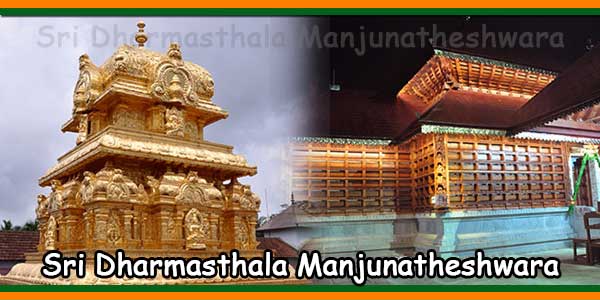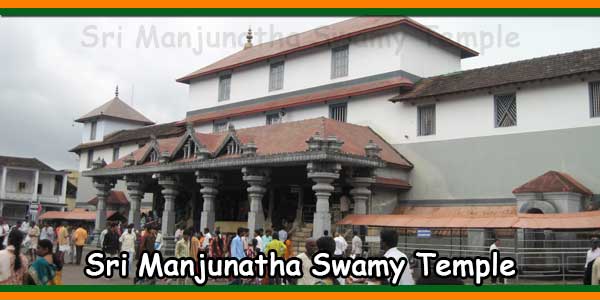Sri Dharmasthala Manjunatha Temple Darshana Timings:
Darshana & Pooja:
Morning – 6:30 AM to 11:00 AM
Afternoon – 12:15 PM to 2:30 PM
Evening – 5-00 PM to 8-30 PM
Abhisheka & Archana: 8-30 AM to 10-30 AM
Thulabhara Seva: 8:00 AM and 1:00 Noon
Sri Kshethra Dharmasthala Sri Manjunatha Swamy Temple is a land of righteousness and piety, is one of the most famous religious monuments in South India, with a history dating back 800 years. lord Shiva in the form of Manjunatheshwara is the main deity of the spiritual home, took the form of a shivalinga and became immaculate, the city of the temple of Dharmasthala forever. This Shiva Kshethra is beseeched by Vaishnava priests and administered by Jain descendants. It is dedicated to the Hindu God, Lord Shiva and is situated in the famous Dakshin Kannada district of the temple town of Dharmasthala.
Dharmasthala, “the dwelling place of the Dharma, is the quintessence of humanity and faith.” As its name suggests, the word Dharma, in its most true sense, means justice, it is the embodiment of the emotions most divine of the world, The creed or religion.
The temple was built according to the architecture of the Kerala temple. The architecture of Kerala temples is different from that of other parts of India. The architectural style of the temple follows and has an inherent simplicity. The temple has a very different architectural style, with a splendid use of wood, stone and metals. The basic structure of the temple is made of granite and laterite.
The temple has a square plan and, therefore, a pyramid roof. The steep, needle-shaped roof is made of wood and is covered with gold-plated copper plates to protect the inner frame of the skeleton of the vigorous monsoons of Western ghats. Recently, a carefully planned renovation was carried out in the temple to renew the wood carvings and to apply methods to protect the architectural components against external physical or climatic adversities.

Sri Dharmasthala Manjunatha Temple Timings:
Morning: 6:30 AM to 4:00 PM
Evening: 5:30 PM to 9:00 PM
Sri Dharmasthala Manjunatha Temple Pooja & Timings:
1) 6:30 AM to 11:00 AM – Sarva Darshan
2) 8:30 AM to 10:30 AM – Shatharudra Abhisheka
3) 11:00 AM to 11:30 AM – Sahasra Namarchana
4) 11:30 AM to 12:00 PM – Naivedyam
5) 12:00 Noon to 12:15 PM – Maha Pooja
6) 12:10 PM – Nithyabali
7) 12:15 PM to 2:30 PM – Sarva Darshan
8) 2:30 PM to 5:00 PM – Temple remains closed
9) 5:00 PM – Temple reopens
10) 5:00 PM to 8:40 PM – Sarva Darshan
11) 8:30 PM to 8:45 PM – Maha Pooja
12) 8:45 PM – Nithyabali
13) 9:30 PM – Temple closing time
Sri Dharmasthala Manjunatha Temple History:
800 years ago, Dharmasthala was called Kuduma in Mallarmadi, a village in south of Kanara. Here lived the Jainist leader Birmanna Pergade and his wife Ammu Ballalthi in a house called Nelyadi Beedu. Simple, pious and affectionate people; The Pergade family was known for its generosity and hospitality to all.
Puranas says the guardian angels of the Dharma took human forms and arrived at the home of Pergade in search of a place where the Dharma was practiced and could continue and spread. As usual, the couple Pergade welcomed these illustrious visitors with all their means and their great respect. Satisfied with their sincerity and generosity, Dharma Daivas appeared in the dreams of Shri Birmanna Pergade. They explained to him the purpose of his visit and asked him to leave his home to worship the Daivas and dedicate his life to spreading the Dharma.
Without question, the Pergades built another house and began worshiping Daivas in Nelyadi Beedu. It continues even today.

As they continued to practice their worship and hospitality, Dharma Daivas appeared again before Shri Birmanna Pergade to build separate sanctuaries dedicated to the four Dharma Daivas: Kalarahu, Kalarkai, Kumaraswamy and Kanyakumari. In addition, Pergade was commissioned to select two persons of noble birth to act as Daivas’ oracles and four persons worthy to assist Shri Pergade in his duties as the Executive Head of the shrines. In return, the Daivas promised Shri Pergade the protection of his family, an abundance of charity and a popularity for “Shri Kshetra”.
As ordered, Shri Pergade built the shrines and invited the Brahman priests to perform the rituals. These priests asked Pergade to also install a Shivlinga next to the Daivas. The Daivas then sent their vassal Annappa Swamy to obtain the idol of Lord Manjunatheshwara from Kadri located near Mangalore. Subsequently, Shree Manjunatha Swamy Temple was built around this idol.
Around the 16th century, Sri Devaraja Heggade invited Sri Vadiraja Swami from Udupi to visit the temple. The Swamiji came willingly but refused to accept Bhiksha (food offering) because the idol of Lord Manjunatha had not been consecrated according to Vedic rites. Shri Heggade then asked Swamiji to re-consecrate the shiva linga himself. Satisfied with the observance of Vedic rites and Heggade’s charity with all, the Swamiyi called the place Dharmasthala the home of religion and charity. Therefore, the roots of charity and religious tolerance established by the Pergades 800 years ago were nourished and reinforced by twenty-one generations of the Heggade family (Heggade is a derivative of Pergade). Today’s Dharmasthala flourishes with the fruit of selfless dedication.
Sri Dharmasthala Manjunatha Temple Dress Code:
Male devotees should remove their shirt and vest before they enter the Sanctum Sanctorum.
Men: White Pancha, Dhoti. Shirt, T-shit and Banians are not allowed. Pant are allowed.
Female: Saree with blouse/ Punjabi Dress with Dupatta / Chudidhar with Dupatta / Half saree
Sri Dharmasthala Manjunatha Temple Sevas:
Sevas to Sri Manjunatha Swamy:
Shatha Rudrabhisheka
Sri Prasada
Theertha Bottle
Bilva Pathrarchana
Karpoorarathi
Panchamruthabhisheka with Ekadasha Rudrabhisheka Brahmadaya, Brahmarpana
Sevas to Sri Ganapathy Swamy:
Panchamruthabhisheka
Appa Naivedya
Panchakajjaya
Karpoorarathi
Sevas to Shri Ammanavaru:
Pavamanabhisheka
Flower Pooja
Panchamruthabhisheka
Kunkumarchana
Karpoorarathi
Sevas to Sri Annappa Swamy:
Special Pooja with Balivada
Bellakai Naivedya
Karpoorarathi
Ganapathy Temple Special Pooja:
Moodappa Pooja
Special Poojas and Utsavas:
Silver Palaki Utsava
Silver Chariot Utsava
Silver Palaki Utsava & Silver Chariot Utsava
Gold Palaki Utsava
Gold Palaki Utsava & Silver Chariot Utsava
Silver Nandi Lalaki Utsava & Deepothsava
Silver Lalaki Utsava, Deepothsava
Ranga Pooja (24 Yede) (Monday and Friday only)
Ranga Pooja (48 Yede) (Monday and Friday only)
Katte Pooje
Vasantha Seve
Special Note:
Utsavas will be performed from Deepavali to Hathanavadhi (May24)
Darshana & Seva timings may change on festival days and special occasions.
Management has rights to change prices without prior notice to the public.
Special Pooja & Utsava can be offered with advance booking only.
On festival days special pooja cannot be offered.
For more details of Thulabara, special utsava and other sevas, contact:
Temple Parupathyagar – Phone: 9945725511
Sri Dharmasthala Manjunatha Temple Festivals:
1) Ganesha Chaturthi
2) Navarathri (Special pooja at Shri Ammanavaru Shrine followed by nine days of religious activities)
3) Deepavali
4) Laksha Deepotsava
5) Shivarathri (Annual Grand festival of lights, celebrated for last five days in the month of Kartika)
6) Chaandramana Ugadi (celebration of new year as per Calendar)
7) Annual Jathre (A nine day Festival conducted in April)
Sri Dharmasthala Manjunatha Temple Annaprasadam Timings:
Annaprasadam is offered every day to thousands of pilgrims, who visit Dharmasthala to seek the blessings of Lord Manjunatha. The food is offered free.
Sunday and Monday:
Morning: 10.30 AM to 4.30 PM
Night : 7:00 PM to 10:00 PM
Tuesday to Saturday
Morning : 11:00 AM to 2.45 PM
Night : 7:00 PM to 10:00 PM
Note:
Dharmasthala Temple Timings may change on special days and on festival days.
Children below the age of 2 years are not allowed inside the sanctum sanctorum.
Breakfast will be offered in the queue line during crowded days.
Restrooms are available alongside the queue line.
Places Near Sri Dharmasthala Manjunatha Temple:
Shri Chandranatha Swamy Basadi
Shri Annappa Swamy Betta
Shri Bahubali Hill
Annapoorna Dining Hall
S.D.M.Oriental Library
Manjusha Museum
Vintage Car Museum
Jama Ugrana
How to Reach Sri Dharmasthala Manjunatha Temple:
By Air:
Mangalore Airport serves as the nearest domestic and international airport for tourists heading to Dharmasthala. It is situated at a distance of 65 km from Dharmasthala.
By Train:
Mangalore Railway Station is the nearest railway Station situated at a distance of 74 km. Travellers can hire taxis/cabs or buses to reach Dharmasthala.
By Road:
Devotees can travel by KSRTC / Karnataka State Road Transport Corporation buses to reach Dharmasthala from all over the state. Private buses or by their own vehicles to reach Dharmasthala.

